
Lemurs endangered by climate change
A new study of primates in the island of Madagascar shows in detail how rainforest biodiversity may be directly impacted by global warming.
Reported in the journal Global Change Biology, it appears that at least one species of Madagascan lemur can be seen as an indicator of climate change.
The research, led by Amy Dunham of US Rice University, found a direct correlation between El Niño climatic events and timings with a threat to the local population of Milne-Edwards’ Sifaka lemurs in Madagascar, a place which is also a refuge for many other unique species.
Dunham’s work throws doubt on a commonly held assumption that biodiversity hotspots like the rainforests of Madagascar and the Western Amazon will play an important role as sanctuaries protecting species against large scale climatic changes.
“This implies that not only is human activity directly impacting on the worlds tropical forests through the penetration of roads, deforestation and mega energy projects, but, to make matters worse, the changing weather conditions from global warming are also having unforeseen negative impacts on biodiversity,” claims Matthew Owen of Cool Earth Action. “All the more reason for everyone to take every action possible to mitigate climate change.”
A leading lemur expert, Dunham’s previous research helped explain why male and female lemurs are the same size. This new study, however, looked into how El Niño weather cycles may increase the rainfall experienced in south eastern Madagascar and how this could impact directly on the reproductive patterns of the Milne-Edwards’ Sifaka lemur.
This primate is particularly vulnerable due to the fact that the female of the species is only sexually responsive for one day a year. The evidence suggests that, since lemurs tend to be inactive during heavy rains, their one day a year opportunity for reproducing could be increasingly missed and have a serious negative impact on the lemur population.